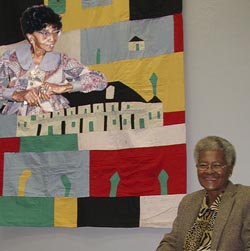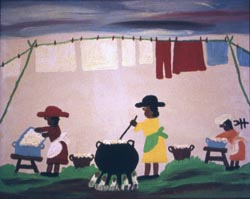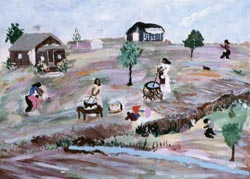Places They Remember: The Art of Clementine Hunter and Sarah Albritton
By Susan Roach and Peter Jones
I tell my stories by marking pictures. The people who lived around here and made the history of this land are remembered in my paintings. I like that. I'm glad the young people of today can look at my paintings and see how easy and uncomplicated things were when we lived off the land. I wanted to tell them. I paint the story of my people. The things that happened to me and the ones I know. My paintings tell how we worked, played and prayed.
—Clementine Hunter quoted in Shelby R. Gilley, Painting by Heart: The Life and Art of Clementine Hunter.
My childhood means a great deal to me simply because of all the suffering I went through to grow up, so I want to paint it; I want to preserve it; it will be here when I'm dead, hopefully. I've written the story, but now I want to tell it in pictures. . . . I wanted to document everything that I could remember that happened to me, and . . . it's not a pretty story at all.
—Sarah Albritton quoted in Susan Roach, ed., On My Way: The Arts of Sarah Albritton.
Fifty years and one hundred miles separate north Louisiana's most significant self-taught African American women painters—Clementine Reuben Hunter and Sarah Drayton Albritton. Hunter (1886-1988) lived on Melrose Plantation near Natchitoches on the Cane River in the west central Louisiana Red River Valley, rich river bottom with alluvial soils, where plantation culture flourished. To the northeast, Albritton (1936- ) has lived in and around Ruston in the gently rolling, pine-covered hills, drained by creeks and bayous, and settled with small yeoman farms. Representing the cultural landscapes of lowland and upland South, their narrative paintings illustrate the importance of place and traditional culture for these women. Their lives, artistic careers, and art painted from memory and vision have fascinating commonalities and contrasts.
Clementine Reuben was born in December 1886, on Hidden Hill Plantation near Cloutierville, to a single mother who later married Clementine's father. According to Gilley and Wilson, Hunter rejected schooling and worked in the Melrose cotton fields from childhood into adulthood. She had two children with Charles Dupre and later married Emanuel Hunter, with whom she had five children (two stillborn), and they raised an adopted relative. As she grew older, she began inside work, and became the fulltime Melrose cook. In addition, she tended vegetable gardens; sewed children's clothes, hand-tied lace curtains, dolls, and quilts; and wove baskets. Around age fifty, she began painting when New Orleans artist Alberta Kinsey visited Melrose. Lyons quotes Hunter:
I liked needlework, sketching, just doing anything with my hands. Then in the 1930s Alberta Kinsey came here from New Orleans to paint magnolias, and I had to clean up her room. She gave me some old tubes of paint to throw in the trash, but I didn't pay her no mind. I kept them and tried marking up some pictures in my cabin. Nobody taught me to mark them. I did it myself 'cause I knew how to do that.
Hunter "marks" her painting, an appropriate term denoting both an illiterate person's signature and an artist's unit of painting and drawing.
At that time, Melrose was a center for writers and artists, including Lyle Saxon, Harnett Kane, Caroline Dorman, and the two who advanced her career, Francois Mignon and James Register. Within ten years, Hunter was featured in a Look magazine article. Even with this national attention, she continued to sell her work for low prices. Art sales enabled Hunter to buy things she could not otherwise afford. As she states in Gilley, "After a while I started getting fifty cents for a painting, then a dollar, then ten, and now it's up to one fifty [$150]. Painting's been a gift from God. It's helped me buy an electric icebox, stove, freezer, radio, television, and a bathroom. And I have a secondhand car." Shelby Gilley recalls buying his first painting in 1970: "She brought out a painting and informed me that I could have . . . that old thing' for $37.50." Over fifty years, she produced and sold around 5000 works; while many resold later at higher prices, her widespread collectors solidified her continuing popularity and place in the art world.
At the same time Hunter took up painting, Sarah Drayton was born in Arcadia to a single mother. She never knew her father. As an infant she was taken to Ruston, where she was shuttled back and forth from her mother to relatives in the country community of Mt. Harmony. She worked after school, learning to short order cook at age nine, and completed high school. She married Robert Albritton, had three children, and raised others as well. Although she never made quilts, she made clothes for her family and the public. She had a cottage canning industry, and worked as a nutritional aide for the LSU Cooperative Service, where she created visual aids. Raised partly on farms, she also kept a vegetable garden and helped start a farmers' market in Ruston. After performing as a cook and storyteller at folklife festivals, she opened her own restaurant, Sarah's Kitchen, in 1987, closing it because of illness in 1999. Sarah's Kitchen became a popular place for athletes, artists, academics, and townspeople.
This popularity led to her selection for a 1993 arts council "Celebrity Paint Off" fundraiser, which provided each celebrity with six acrylic paints and a canvas to produce a painting for auction, kicking off her career in high profile fashion. She then began painting her childhood stories, which led to her first exhibition at Louisiana Tech University in March 1996, and a feature article in Fall 1996 Louisiana Cultural Vistas. A statewide traveling exhibition and catalog, On My Way: the Arts of Sarah Albritton, followed in 1998-2000. Until her recent exhibition at New Orleans' Stella Jones Gallery, a leading dealer in African-American art, Albritton herself has priced and sold her work. Her first exhibit prices ranged from $650 to $1200; now they are in line with the mainstream art market, instead of the typically lower-priced self-taught market.
Both women's paint choices influence their styles. Hunter's first paintings were done with cast off oil paints, and contain many of the earth colors useful to academic painters. These early works, typically thinly-painted, often differ from her quilts, lush with strong, vibrant colors. Later, with access to more colors, her paintings resemble her textiles more. Hunter appears to paint in one layer with minimal rearranging with bold shapes, a testimony to her strong vision and expressive handling of the slow-drying oil medium. Albritton has generally worked in acrylic paints, unavailable to Hunter in her early years, which dry quickly, allowing rapid changes. She uses artists' acrylics and commercial premixed "Folk Art" colors. Albritton paints some elements in relief, using thickened paint, acrylic modeling paste, and even cigarette tobacco. Each artist responds to the characteristics of her paint.
Both women paint on standard artists' surfaces and found objects, using scraps of time. Hunter's early work includes scavenged window shades and pieces of cardboard, and unorthodox objects like buckets, bottles, and boxes, for which she maintained a fondness. In addition to her figurative quilts, Hunter appliquéd bed hangings and painted the murals for the Melrose African House. At first, Albritton used drawing and watercolor papers, canvas boards, and stretched canvases from art supply stores, but she loves unconventional surfaces and textures—molded door panels, screens, cypress knees, pottery, and jelly jar lids. She too painted murals in her house. Characteristic of busy older women, both steal time for art late at night.
Portrayal of space differs for the two. Hunter's spatial organization reflects her quilt designs, often with simple, repeated groupings in rows, reminiscent of strip quilts. Her figures are usually represented in profile, characteristic of appliqué quilts, e.g. "Sunbonnet Sue," with strongly marked eyes and noses. Frequently, her backgrounds are unpainted or painted one color. Inspired by the flat river bottom landscape, Hunter's figure groups are represented at eye level, even when repeated on different levels of the canvas, whereas Albritton's employ an elevated perspective, the "bird's-eye" view common to many memory painters, which enables her to people her landscapes with multiple groups of figures (often named in the accompanying stories). Albritton's scenes are closest in style to Hunter's African House murals, in which the background is fully realized.
Both women depict their regional landscapes and folk traditions such as crop production and harvesting (cotton picking, pecan thrashing, syrup making); domestic chores (women's work, clothes washing); pastimes and celebrations (fishing, barbecues, picnics, homecomings, Christmas, community dances, and honky tonks); and religious rituals (outdoor baptism, funerals). Hunter is more the objective historian, while Albritton usually places herself in her own work as a protagonist. The nearby Cane River appears in Hunter's paintings of fishing and baptism, a favorite subject according to Gilley: "What I like is a baptism, because I've seen 'em go in the water a many, a many, a many a time." The small streams of Albritton's hill country serve her as a symbol of poverty, a source of food for scavenging children, a place for prayer, and a boundary between blacks and whites: "Everywhere I have been a stream of water has followed me." In their religious paintings, Hunter focuses more often on the birth of Christ, and Albritton, the crucifixion, possibly reflecting their Catholic and Baptist faiths. Both delight in depicting baptisms and angels, and profess a belief in guardian angels. Angels soar in their murals, and both insist that their talents are "gifts from God."
Typically, Hunter's paintings represent people in harmony with their environment, while Albritton's often represent the politicized perspective of a younger generation. Hunter's cotton picking scenes focus on the details of the harvest. Having learned from her father, she was proud she could pick 250 pounds. A different generation, Albritton, proud of the fact that she hates cotton, focuses on economic and time difficulties of the harvest, paints a community helping a sharecropper in Neighbors Picking Cotton. Again, Albritton's painting of her childhood home Tarbor Quarters echoes Hunter's portrayals of Melrose Plantation, but actually, Albritton's big white house belongs to a white doctor, who rents out the unpainted shotgun houses. It is an edgier image than the pastoral scenes of Melrose.
Hunter's career helped prepare a place for Albritton's work, although they never met. Hunter belonged to the first wave of interest in self-taught art, when New York's Museum of Modern Art was featuring self-taught artists like African American sculptor William Edmunds. Modernist artists and critics looked to such art for strong color and shape and powerful direct expression. Hunter's work continues to appeal because its undeniable charm is coupled with a powerful and original sense of form. Albritton's work came to attention of artists and collectors during the second great period of interest in self-taught art. Perhaps reflecting the post-modernist preference for narratives instead of pure form, her audience is drawn to personal narratives accompanying her paintings. Their stories converge as the role of cook gives them access to power, leading to artistic careers of great authority. Their gifts of art transform them into griots for their homeplaces and wise women for the world.
Notes and Sources
Although we were not privileged to work with Clementine Hunter, one of our most rewarding research experiences has been working with Sarah Albritton. Facts and quotes on Hunter have been drawn from the following resources:
Gilley, Shelby R. 2000. Painting by Heart: The Life and Art of Clementine Hunter. Baton Rouge: S & Emma Press.
Hunter, Clementine. 1998. Talking with Tebe: Clementine Hunter, Memory Artist. Ed. Mary E. Lyons. Boston: Houghton Mifflin Company.
Roach, Susan, ed. 1998. On My Way: The Arts of Sarah Albritton. Ruston, La.: Louisiana Tech University.
Wilson, James L. 1988. Clementine Hunter: American Folk Artist. Gretna: Pelican.





